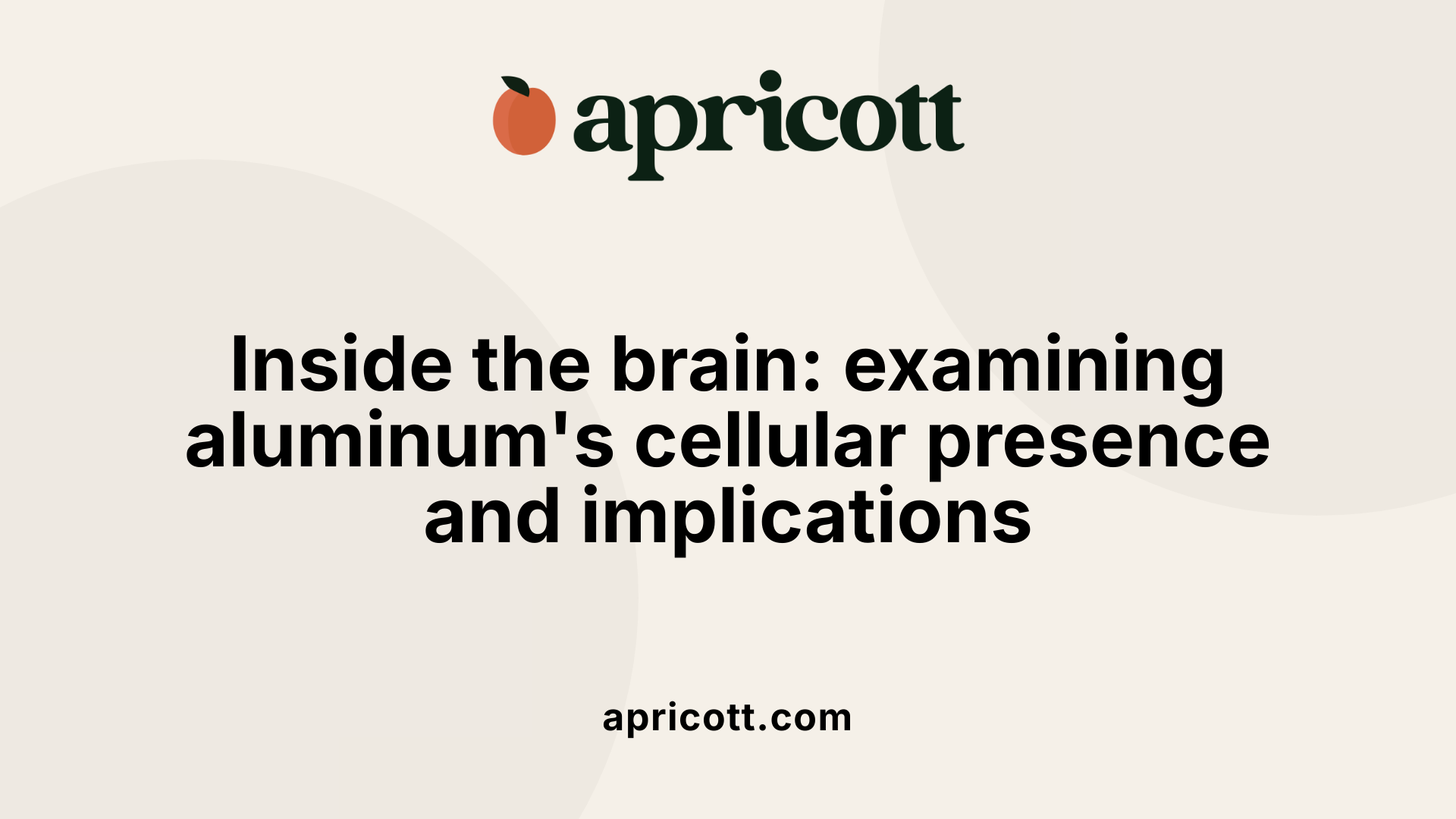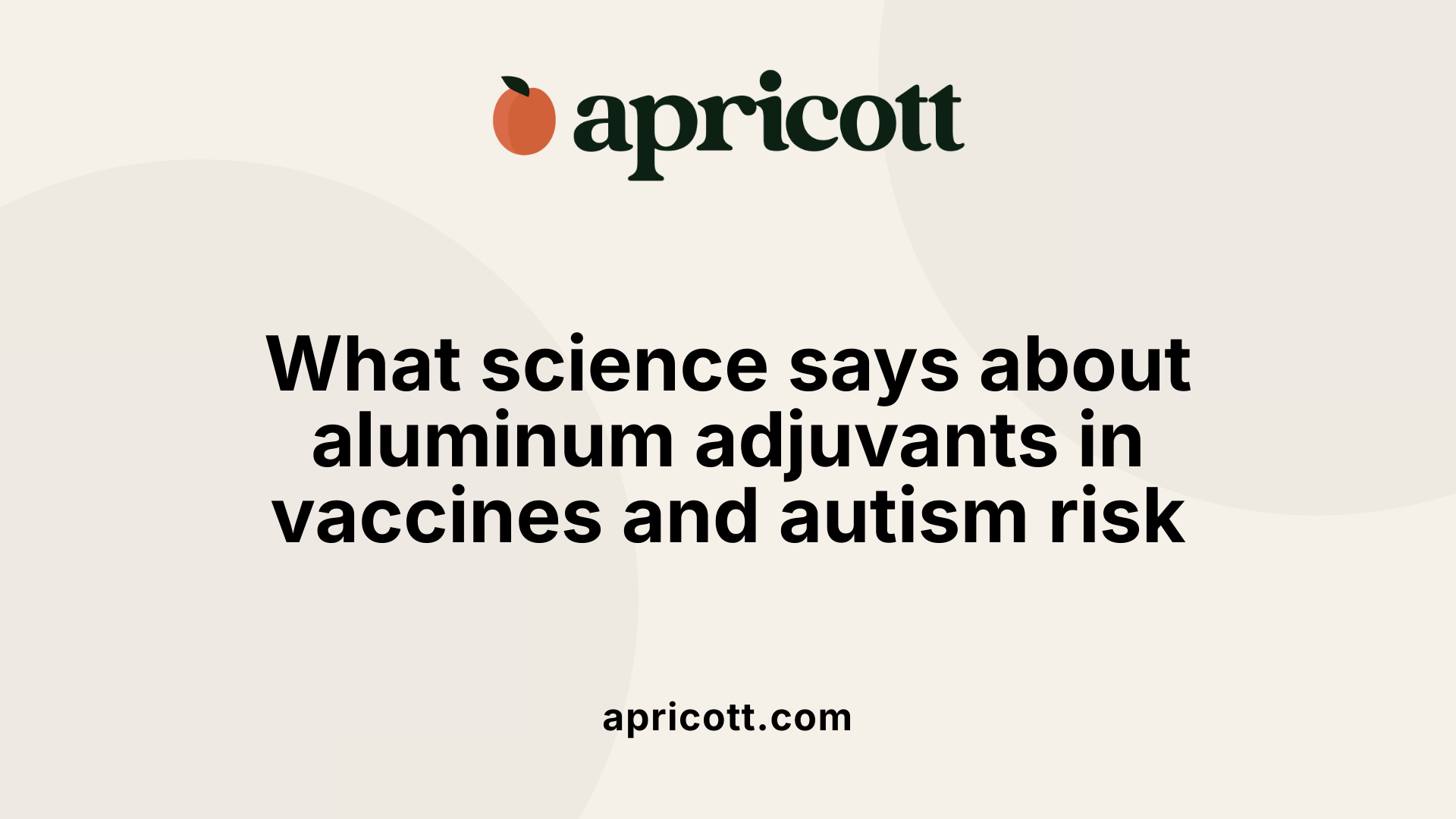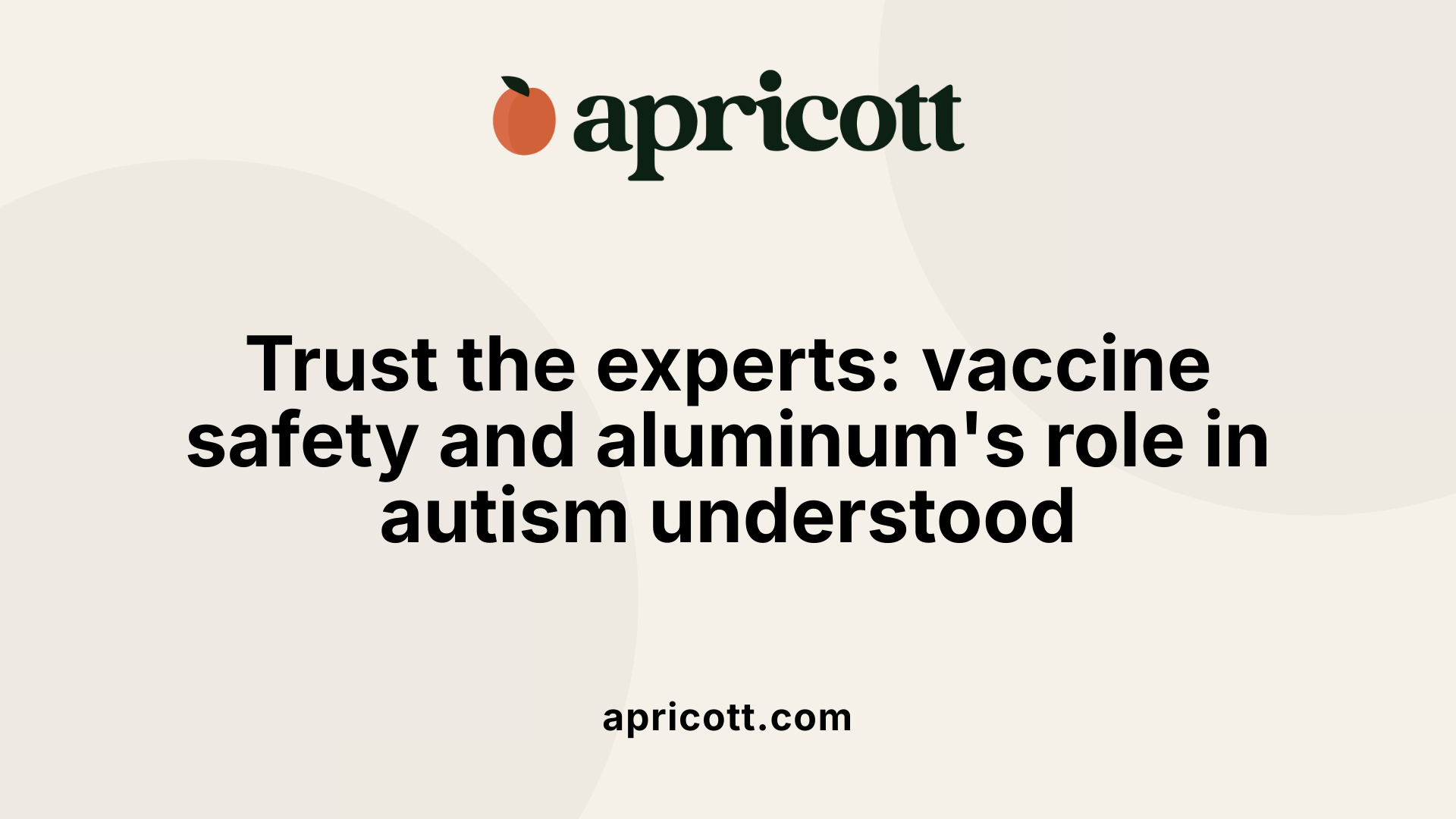Exploring the Evidence on Aluminum and Autism Spectrum Disorder
The question of whether aluminum exposure contributes to autism spectrum disorder (ASD) has been a topic of scientific investigation and public debate. This article synthesizes current research findings, expert opinions, and epidemiological data to evaluate the potential link between aluminum—particularly as used in vaccines—and autism. While some studies suggest a possible association based on brain tissue analysis and regional exposure patterns, extensive large-scale research has consistently found no conclusive evidence to support causality. Here’s a detailed look at what science tells us.
Presence of Aluminum in Brain Tissue of Individuals with Autism

How is aluminum measured in the brain?
Recent studies have employed advanced techniques such as transversely heated graphite furnace atomic absorption spectrometry to accurately measure aluminum levels in brain tissue. This method allows researchers to detect trace amounts of aluminum with high sensitivity and precision, ensuring reliable data collection.
How is aluminum distributed across different brain regions?
In individuals diagnosed with autism, aluminum was found consistently in multiple key brain regions, including the occipital, frontal, temporal, and parietal lobes. The average aluminum content varied across these regions, with the occipital lobe and parietal lobes showing the highest levels at approximately 3.82 micrograms per gram of tissue. The frontal lobe had a lower mean at 2.30 μg/g, while the temporal lobe was at 2.79 μg/g. These findings highlight a widespread distribution of aluminum throughout the brain in autism cases.
Where is aluminum found within brain cells?
Microscopic analysis revealed that aluminum associates closely with neurons and is present inside various cell types, including microglia-like cells and other inflammatory, non-neuronal cells. These cells are located throughout brain tissue, in the meninges, blood vessels, and both grey and white matter. The intracellular presence of aluminum suggests it might influence cellular functions and inflammatory responses within the brain.
What does this mean for autism?
The detection of elevated aluminum levels, especially its intracellular association with neurons and immune-like cells, raises concerns about potential neurotoxic effects. It also suggests a possible link between aluminum accumulation and the inflammatory processes observed in autism. However, while the presence of aluminum is well-documented, establishing a direct causal relationship with autism requires further investigation.
| Aspect | Observation | Implication |
|---|---|---|
| Measurement method | Graphite furnace atomic absorption spectrometry | Enables sensitive detection of aluminum levels |
| Brain regions affected | Occipital, frontal, temporal, parietal lobes | Aluminum distributed across multiple regions |
| Aluminum level (mean) | 3.82 μg/g (occipital, parietal), 2.30 μg/g (frontal), 2.79 μg/g (temporal) | Elevated levels in autism brains |
| Cellular association | Found inside neurons, microglia-like cells, and inflammatory cells | Potential role in neuroinflammation |
| Overall significance | Presence in various regions and cell types in autism brains | Suggests possible neurotoxic effects or involvement in pathology |
Is there scientific evidence regarding the presence of aluminum and its health implications in relation to autism?
Scientific studies have documented increased aluminum content in the brains of individuals with autism. In particular, some evidence points to aluminum being associated with neurons and immune cells, which could influence neuroinflammation—a process often observed in autism. There remains a debate about the sources of aluminum exposure, with some researchers exploring links to vaccines that contain aluminum adjuvants.
However, large-scale epidemiological research, including a detailed 24-year Danish study involving over 1.2 million children, found no conclusive evidence that aluminum in vaccines causes autism or other neurodevelopmental disorders. This extensive study examined vaccination records, including aluminum exposure, and multiple health conditions, finding no increased risk related to aluminum-containing vaccines. The study reinforces the safety profile of current vaccination practices.
Despite the documented presence of aluminum in the brain, current scientific consensus suggests that aluminum exposure from vaccines, in the amounts used, is unlikely to be a direct cause of autism. Nonetheless, the accumulation of aluminum in brain tissue continues to warrant further research to understand potential neurotoxic effects and mechanisms.
Research on Aluminum in Vaccines and Autism Risk

What is the role of aluminum as a vaccine adjuvant?
Aluminum salts are widely used in vaccines as adjuvants. Their primary function is to enhance the immune response, helping the immune system recognize and respond to the vaccine's antigens more effectively. This approach allows vaccines to be more effective while using smaller amounts of antigens, which can boost vaccine safety and efficacy.
In vaccines, aluminum is present in very minute amounts and is utilized because of its ability to stimulate the immune system. It is not intended to remain in the body indefinitely; most aluminum from vaccines is cleared out within weeks. Despite this, concerns have been raised about the potential neurotoxic effects of aluminum, especially in children.
Are there concerns about aluminum exposure from vaccines and autism?
Some speculations and early hypotheses suggested a possible link between aluminum adjuvants and autism spectrum disorder (ASD). These concerns gained attention because aluminum is known to be a neurotoxin at certain levels, and some countries with higher usage of aluminum-containing vaccines coincidentally reported higher ASD prevalence.
However, extensive scientific research has overwhelmingly shown no causal connection. A significant 24-year study conducted in Denmark involving over 1.2 million children is among the most comprehensive. This study specifically examined the relationship between aluminum exposure from vaccines administered in early childhood and a wide range of chronic health conditions, including autism.
The results revealed no increased risk of autism associated with aluminum exposure from vaccines. The hazard ratios for autism and other conditions were close to 1, indicating no significant risk increase. Moreover, no dose-response relationship was observed, which is a critical aspect of establishing causality in epidemiology.
How do animal studies and global data inform this debate?
Animal research adds another layer of evidence. Studies involving mice exposed to aluminum have demonstrated behavioral changes, supporting the idea that aluminum can influence neurological function. Nonetheless, translating findings from animal models to humans is complex, and such effects have not been conclusively demonstrated in children following vaccination.
When examining global data, the correlation between aluminum exposure and ASD prevalence appears compelling but does not establish causality. Countries with higher vaccine-related aluminum exposure often report higher ASD rates. Still, this correlation may be confounded by differences in diagnostic practices, awareness levels, ecological factors, and other environmental or genetic influences.
To evaluate potential causality, scientists often apply Hill's criteria, considering factors like strength, consistency, temporality, biological plausibility, and dose-response. Some analyses show a high correlation (for example, Pearson r=0.92 in the United States) between aluminum exposure and ASD prevalence over the last two decades. Yet, correlation alone cannot prove causation.
What is the current scientific consensus?
Despite the concerns, current scientific and regulatory assessments advocate the safety of aluminum adjuvants in vaccines. Large-scale studies and reviews by health authorities such as the World Health Organization (WHO) and the Centers for Disease Control and Prevention (CDC) have found no credible evidence linking aluminum in vaccines to autism.
Furthermore, aluminum in vaccines is rigorously tested for safety before approval. The amount used is much lower than the threshold levels associated with toxicity in experimental settings. Additionally, the body's natural processes efficiently eliminate aluminum from the system.
Overview table of aluminum exposure, vaccine safety, and autism risk
| Aspect | Details | Additional Notes |
|---|---|---|
| Aluminum in vaccines | Used as an adjuvant in small doses | Most cleared within weeks |
| Autism risk | No evidence of increased risk | Based on large epidemiological studies |
| Global ASD prevalence | Rising in some countries | Correlated with various environmental factors |
| Animal studies | Show behavioral effects | Do not directly translate to humans |
| Regulatory stance | Aluminum adjuvants considered safe | Endorsed by WHO, CDC |
Is there a confirmed link between aluminum exposure from vaccines and ASD?
Based on the best available scientific evidence, including large epidemiological studies such as the Danish cohort, there is no confirmed causal relationship between aluminum in vaccines and autism spectrum disorder. While ongoing research continues to monitor safety, current data support the conclusion that these vaccines are safe and do not contribute to the development of ASD.
In summary, although aluminum is a neurotoxin at high doses and is used as a vaccine adjuvant, there is no credible evidence to associate it with autism. The evidence from diverse research efforts supports the safety of current vaccination practices, ensuring public health protection globally.
Evaluating Causality: Does Aluminum Cause Autism?
What does the epidemiological evidence say about aluminum and autism?
Research into the potential link between aluminum exposure and autism spectrum disorder (ASD) has generated mixed insights. Some studies observe that brain tissues from individuals with autism contain higher levels of aluminium across various regions, such as the occipital, frontal, temporal, and parietal lobes. For instance, the average aluminium content was recorded as high as 3.82 μg/g in the occipital and parietal lobes, marking some of the highest levels found in human brain tissue. These findings suggest a possibility of aluminium accumulation being associated with autism.
On the other hand, extensive population-based studies provide reassuring evidence. The large Danish cohort study, which analyzed data from over 1.2 million children, found no association between early childhood vaccination with aluminium-adjuvanted vaccines and neurodevelopmental conditions including autism. The study focused on various health outcomes, accounting for confounding factors, and concluded that exposure to aluminium from vaccines does not increase risks for autism or other immune or allergic conditions.
Additionally, correlational studies on aluminum exposure levels and autism prevalence across different countries show strong relationships. For example, in the United States, a Pearson r value of 0.92 indicates a high correlation between vaccine aluminium exposure and autism prevalence. Yet, correlation does not imply causation, and these ecological data alone cannot determine a direct cause-effect relationship.
What are the mechanisms behind aluminum neurotoxicity?
Aluminium is recognized as a neurotoxic metal capable of affecting brain development and function. Laboratory studies and animal models suggest multiple mechanisms through which aluminium could exert harmful effects:
- It can induce oxidative stress, damaging neurons and supporting cells.
- Aluminium has the ability to interfere with cellular signaling pathways crucial for neurodevelopment.
- It can provoke inflammatory responses by activating microglia and other immune components within brain tissue.
- Aluminium may also disrupt the blood-brain barrier, allowing additional toxins to enter the brain.
Despite these mechanisms being demonstrated in experimental settings, the critical question remains whether such effects occur at the levels of aluminium exposure typical of current vaccination practices.
How do Hill's criteria inform the debate on causality?
The Bradford Hill criteria provide a framework to evaluate whether an observed association reflects causation. Applying these criteria to the aluminum-autism hypothesis involves considering factors like strength of association, consistency, temporality, biological plausibility, and dose-response relationships.
While some correlations between aluminum exposure and ASD show strong statistical significance, other criteria such as consistent findings across numerous studies and biological plausibility require further substantiation. Currently, the body of evidence does not satisfy all Hill's criteria convincingly to establish causality.
In summary, although there are observations of elevated aluminium in autistic brains and some correlations at the population level, the overall scientific consensus, supported by large epidemiological studies, indicates no causative link between aluminium exposure—primarily through vaccines—and autism. Ongoing research continues to monitor and evaluate these complex interactions, emphasizing the importance of rigorous scientific methodology to inform public health policies.
| Aspect | Findings | Notes |
|---|---|---|
| Brain aluminium levels | Elevated in autism brains | Consistent across multiple regions |
| Epidemiological studies | No link found | Danish cohort study, large sample size |
| Population correlations | Strong associations | Ecological data, cannot prove causality |
| Biological mechanisms | Potential neurotoxic effects | Demonstrated in animal and cell studies |
| Hill's criteria application | Insufficient evidence for causality | Further research needed |
What does authoritative health guidance say?
Leading health organizations, including the World Health Organization (WHO) and the Centers for Disease Control and Prevention (CDC), reinforce that vaccines containing aluminium adjuvants are safe. These organizations state that no scientific evidence supports a causal link between vaccine aluminium and autism. They emphasize the importance of vaccination in preventing serious diseases and highlight the lack of credible data to support claims of harmful effects from aluminium at present prophylactic doses.
Expert Consensus and Public Health Perspectives

What is the scientific consensus or expert opinion on the relationship between aluminum (particularly in vaccines) and autism?
The prevailing scientific view, supported by numerous health organizations worldwide, is that there is no credible evidence linking aluminum in vaccines to autism. Major health authorities such as the World Health Organization (WHO), Centers for Disease Control and Prevention (CDC), and other scientific bodies have extensively reviewed the available research.
Extensive studies, including a significant 24-year investigation involving over 1.2 million children in Denmark, have found no association between vaccines containing aluminum adjuvants and the development of autism spectrum disorder (ASD). These studies employed rigorous methodologies, carefully adjusting for various confounding factors, and consistently demonstrated the safety of aluminum in vaccines.
Research has also shown that aluminum is used in vaccines as an adjuvant to enhance immune responses. It is administered in very small quantities and is largely cleared from the body within weeks. Furthermore, large-scale epidemiological data from multiple countries have established that there is no increased risk of neurodevelopmental disorders, including autism, related to aluminum-containing vaccines.
The overwhelming scientific evidence supports vaccinating children as scheduled, emphasizing that the benefits of immunization far outweigh any perceived risks. Disruption or delay in vaccination programs can lead to increased susceptibility to serious infectious diseases, which pose far greater health risks than the minute and well-understood exposure to aluminum in vaccines.
Comparison of Al Exposure and Autism Prevalence Across Countries
Many epidemiological studies reflect a positive correlation between aluminum exposure from vaccines and autism prevalence. For instance, in the United States, a strong positive correlation (Pearson r=0.92, p<0.0001) has been observed over the last two decades.
Similarly, analyses across seven Western countries reveal a significant correlation (Pearson r=0.89-0.94, p=0.0018-0.0248) between the amount of aluminum administered to preschool children and ASD prevalence. These correlations have prompted discussions about potential causality based on Hill's criteria, suggesting that aluminum exposure could contribute to ASD risk.
However, comparative studies also consider confounding variables such as genetic factors, environmental influences, and differences in diagnostic criteria. Despite these considerations, no conclusive causal link has yet been established.
Why Delaying or Avoiding Vaccination Poses Risks
Delaying or skipping vaccines can leave children vulnerable to preventable infectious diseases, which can cause severe illness, complications, or death. Vaccines have been developed through rigorous scientific processes and have been proven to be safe and effective.
Interruptions in immunization schedules can lead to outbreaks of diseases like measles, mumps, and whooping cough, which can have devastating health impacts. Moreover, the widespread immunization coverage has contributed to the near-eradication of certain diseases, demonstrating the importance of maintaining vaccination programs.
Public Health Recommendations
All major health authorities reinforce the safety of vaccines containing aluminum. They emphasize that the small amounts used are safe and that the risks associated with vaccine-preventable diseases far outweigh any minimal and well-understood risks from aluminum exposure.
Continuing to rely on evidence-based vaccination strategies is essential for protecting individual and community health, especially considering children’s heightened vulnerability during early development.
| Topic | Details | Source/Notes |
|---|---|---|
| Aluminum in vaccines | Used as an adjuvant to boost immune response | Small doses, largely eliminated within weeks |
| Autism and vaccines | No credible link established | Numerous high-quality studies and reviews |
| Significant studies | Danish cohort study (1.2 million children), others | Show no association |
| Exposure levels and prevalence correlation | Higher aluminum exposure aligns with increased ASD rates in some analyses | Correlation does not confirm causation, but warrants further study |
| Risks of delaying vaccination | Increased vulnerability to preventable diseases | Outbreaks and health complications |
| Global vaccination impact | Saved over 154 million lives in past 50 years | WHO, CDC data |
The consensus remains clear: vaccines with aluminum are safe, effective, and crucial for public health. Ongoing research continues to monitor safety, but current evidence strongly favors continued vaccination without fear of causing autism.
Synthesizing the Evidence: What Do We Know About Aluminum and Autism?
While research has uncovered higher aluminum levels in brains of individuals with autism and suggested possible neurotoxic mechanisms, large epidemiological studies have not established a causal link between aluminum exposure—particularly through vaccines—and autism spectrum disorder. Regulatory agencies and health authorities worldwide continue to endorse the safety of aluminum adjuvants in vaccines, emphasizing that the benefits of immunization significantly outweigh any unproven risks. The current scientific consensus remains clear: aluminum in vaccines does not cause autism. Continued research is necessary to further clarify the neurobiological impacts of aluminum, but at present, there is no definitive evidence to support the notion that aluminum causes autism.
References
- Aluminium in brain tissue in autism
- Reviewing the association between aluminum adjuvants in ...
- No link between aluminum-adjuvanted childhood vaccines ...
- Study finds no link between aluminum in vaccines and ...
- WHO statement on autism-related issues
- Do aluminum vaccine adjuvants contribute to the rising ...
- Aluminium in brain tissue in autism
- Reviewing the association between aluminum adjuvants in ...
- Aluminum-Adsorbed Vaccines and Chronic Diseases in ...
- Do aluminum vaccine adjuvants contribute to the rising ...
.svg)
.svg)








